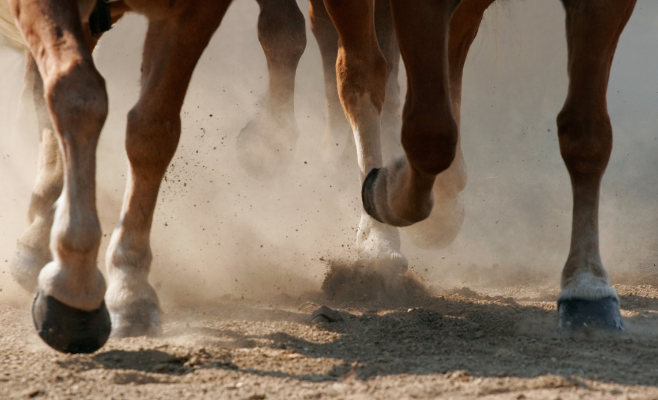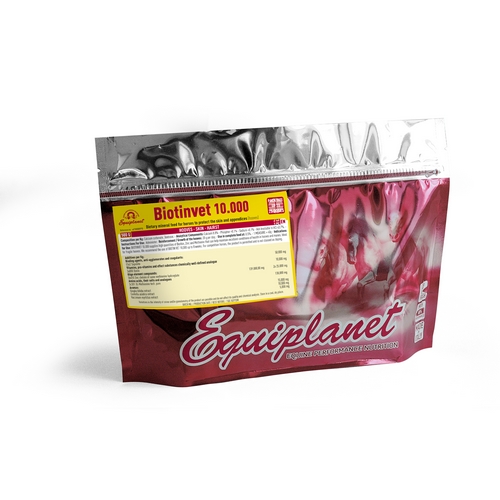
Colts and Fillies taming and training: 7 nutritional tips
17 May 2021
Fats or oils in horse feeding
27 October 2021Biotin for horses: how and when to use it

Biotin is a nutrient that has been focused on for many years for its effect on hoof growth and health. However, it is not the only substance that influences the quality of skin, hair and skin attachments. Let’s find out more about its use.

What is biotin?
Biotin is a water-soluble B group vitamin that plays an important role as an enzyme cofactor in metabolism. Horses, humans and other mammals are unable to synthesise biotin. This vitamin must be obtained through the diet or through the absorption of biotin synthesised by intestinal bacteria.

From which feeds can the horse get biotin?
The absolute first source of biotin is pasture. This vitamin is found in high concentrations in alfalfa, in moderate concentrations in oats, barley and soya meal, and only in low levels in maize. The amount of biotin that horses obtain through the diet varies between individual horses and groups of horses in particular geographical locations. In addition, the amount of biotin produced by the gut microbial flora is also variable.
When is it most commonly used?
Biotin is usually used in horses when the owner or farrier notices a fragile hoof with cracks, chipping, flaking of the lower parts and difficulty in maintaining the shoeing. As for the coat, its use is necessary when there are areas of alopecia or weakness of the horsehair.

How long should biotin be used in horses?
The use of biotin should be continued for prolonged periods (6-9 months) in order to help improve the quality of the horny tissue of horses with hoof problems. In practice, supplementation with biotin increases the consistency and strength of the horny tissue but does not affect the speed of growth. Researchers at the University of Edinburgh say it is essential to inform owners that results will not be evident for 8 to 12 months after starting supplementation.

How much biotin should a horse be given?
There are several studies carried out on the use of biotin in horses, none of them particularly recent, but they all agree that the useful amount to supplement is 20 mg per day. However, beneficial effects on hoof hardness have been seen with very high amounts of biotin for prolonged periods, especially in those subjects who have always shown the fragility of the horny component.
How do you choose which biotin for horses to buy?
It may go without saying, but the use of a complementary feed for horses is strongly recommended, avoiding products for human use or other domestic species. It is important to rely on established brands on the market, because they can source quality raw materials and additives and at the same time are subject to controls by authorities that ensure animal health and welfare. For this last reason, it is always better to prefer a product made in Italy. Biotin supplementation is on average expensive, well over one euro per day per horse, so it is important to be wary of very cheap products on the market.


What does Biotinvet 10.000 provide?
Biotinvet 10.000 is a dietary mineral feed that provides 10,000 mg of biotin per kg of product. For this dietary feed for horses for hoof and skin regeneration, the recommended daily amount is 20 g per day, to provide 200 mg of biotin per day per horse. Biotinvet also provides Methionine and Zinc, which play a key role in hoof integrity.
What is the difference between complementary feed and dietary feed?
Complementary feeds are formulated with a high content of certain substances but which are only sufficient for a horse’s daily ration when combined with other feeds. Dietetic feeds, on the other hand, are able to satisfy a particular nutritional purpose of animals whose functionality (e.g. hoof regeneration) is likely to be impaired shortly or is impaired temporarily in an irreversible manner. Horses benefit from the intake of this type of feed because it meets the needs of their state of health.

Do you have doubts about the use of biotin in your horse? Are you looking for a solution to improve the resistance of your horse’s feet? Is it shoeing or barefoot? Write to info@equiplanet.it and we will be happy to advise you.
Bibliography
- Effect of dietary biotin supplement on equine hoof horn growth rate and hardness E. A. Buffa, 1992
- Hoof horn abnormalities in Lipizzaner horses and the effect of dietary biotin on macroscopic aspects of hoof horn quality. H. Josseck, 1995
- ‘No hoof no horse?’. JD Reilly. Equine Veterinary Journal, 1995
- Effect of supplementary dietary biotin on hoof growth and hoof growth rate in ponies: a controlled trial. J. D. Reilly, 2010
- Biotin: Biochemical, Physiological and Clinical Aspects. Hamid M. Said, 2011
- Assessment of Biotin Deficiency in Animals C. Whitehead, 1985
- Histological and physical assessment of poor hoof horn quality in Lipizzaner horses and a therapeutic trial with biotin and a placebo. W. Zenker, 1995
To follow the monthly information from Equiplanet, subscribe the newsletter.

